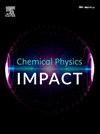Enhanced solar energy harvest in dye-sensitized solar cells using silver-doped TiO2 Photoelectrodes via Spray Pyrolysis
IF 4.3
Q2 CHEMISTRY, PHYSICAL
引用次数: 0
Abstract
This study focuses on doping TiO2 with trace amounts of Ag⁺ ions, employing spray pyrolysis to prepare the Ag-doped TiO2 photoelectrode for application in Dye-Sensitized Solar Cells (DSSCs). In this regard, Ag-doped TiO2 nanomaterials were initially synthesized from Titanium(IV) isopropoxide (TTIP) with varying concentrations of Silver nitrate (AgNO3). The structural and optical characterizations of the synthesized nanomaterials confirmed the presence of TiO2 in pure anatase phase and enhanced light absorption, respectively. The morphological characterization of Ag-doped TiO2 nanomaterials revealed spherical shaped particles. Subsequently, the DSSCs were fabricated using Ruthenium-based N719 dye and imidazolium iodide/ triiodide redox couple as the sensitizer and electrolyte, respectively. Photovoltaic performances were evaluated under simulated solar irradiation (100 mW cm−2, 1 sun, AM 1.5). The optimized device with 3 mmol % Ag-doped TiO2 photoelectrode exhibited PCE (η) of 8.32 %, which was about 13 % greater than the device with un-doped TiO2 (η = 7.35 %). The observed upsurge in PCE is due to the 10 % increase in short-circuit current density (JSC) value resulting from enhancement in visible light absorption which was confirmed by UV–Visible spectroscopic analysis. Moreover, an improved electron transport in the Ag-doped TiO2 based device was confirmed by electrochemical impedance spectroscopic study which is ascribed to the significant reduction in charge recombination. These findings demonstrate the potential of Ag-doped TiO2 for enhanced DSSC performance, offering a viable pathway for improving solar energy conversion efficiency.

通过喷雾热解方法利用掺杂银的TiO2光电极增强染料敏化太阳能电池的太阳能收获
本研究主要采用微量Ag +离子掺杂TiO2,采用喷雾热解法制备用于染料敏化太阳能电池(Dye-Sensitized Solar Cells, DSSCs)的Ag掺杂TiO2光电极。在这方面,最初以异丙酸钛(TTIP)和不同浓度的硝酸银(AgNO3)为原料合成了ag掺杂的TiO2纳米材料。合成的纳米材料的结构和光学表征证实了TiO2分别存在于纯锐钛矿相和增强的光吸收中。ag掺杂TiO2纳米材料的形貌表征显示为球形颗粒。随后,以钌基N719染料和咪唑碘化/三碘化氧化还原偶对分别作为敏化剂和电解质制备DSSCs。在模拟太阳辐射(100 mW cm−2,1太阳,AM 1.5)下评估光伏性能。优化后的3 mmol % ag掺杂TiO2光电极的PCE (η)为8.32%,比未掺杂TiO2光电极的PCE (η = 7.35%)高约13%。观察到PCE的激增是由于短路电流密度(JSC)值增加了10%,这是由于可见光吸收的增强,这是由紫外可见光谱分析证实的。此外,电化学阻抗谱研究证实了ag掺杂TiO2基器件中电子传递的改善,这归因于电荷重组的显著减少。这些发现证明了ag掺杂TiO2增强DSSC性能的潜力,为提高太阳能转换效率提供了一条可行的途径。
本文章由计算机程序翻译,如有差异,请以英文原文为准。
求助全文
约1分钟内获得全文
求助全文
来源期刊

Chemical Physics Impact
Materials Science-Materials Science (miscellaneous)
CiteScore
2.60
自引率
0.00%
发文量
65
审稿时长
46 days
 求助内容:
求助内容: 应助结果提醒方式:
应助结果提醒方式:


